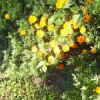Add your voice! Click below to answer. ThriftyFun is powered by your wisdom!

EasyInstructionsThings You'll Need:
Pruning shears
Garden gloves
Chicken wire
Shovel
Fertilizer
Water
Step 1Find out if the hydrangeas are the type that bloom off of old wood-growth from previous years. Hard winters can damage old growth, causing it to die back. If this is the case, there will be no flowers during the current growing season. Protect old-wood growth by building a chicken wire cage around the plant and filling it with leaves and pine needles to help insulate the plant during the winter months.
Step 2Don't over-prune hydrangeas that bloom off of old growth in early summer or late winter because the plant will die back even further, resulting in no buds to put forth blooms. Prune in the spring when the buds can be seen.
Step 3Plant hydrangeas in shade but not too much shade. If the plant is producing beautiful leaves but no flowers then it's getting too much shade. Transplant to another location.
Step 4To much fertilizer and water or not enough fertilizer and water will cause the plant to not flower. Fertilize in early spring and early autumn using a time-release formula. A time release fertilizer mix of 10-10-10 or 16-16-16 works well.
Step 5Transplant non-blooming hydrangeas to sides of buildings or northern and eastern slopes for better protection during the winter months. Also plant under evergreen trees, which will offer good protection.
I would go with the right fertilizer. You might have been using the kind that works on the roots (nitrogen based) and not the flowering. The 10-10-10 should be fine or ask at a local nursery if you want to really push the blooms.
Add your voice! Click below to answer. ThriftyFun is powered by your wisdom!